National Raisin Company of Fowler, California, had good news and bad news. The good news was that sales and production of its Champion Raisin products were rapidly increasing. The bad news was that their wastewater costs were increasing just as fast. Fortunately, thanks to a new membrane filtration system, National Raisin not only has been able to cut their wastewater costs, but they have also opened up a potentially lucrative source of additional income. While this particular solution is currently used only in raisin processing, producers of any dried fruit—prunes, dried apricots, etc.—would likely find similar benefits.
Processing about 50,000 tons of raisins per year (200 tons per day), National Raisin is the second largest processor and distributor of raisins in the USA. The company generates between 60,000 and 80,000 gal/day (227125 and 302833 liters/day) of wastewater, primarily from the raisin-washing process. Raisins have a fine coating of dust blown onto them from the sandy soil in the Central Valley of California, and this needs to be washed off before packaging
If this dust was the only problem, simple settling tanks or filters could eliminate it and the wash water could be re-used for irrigation and other purposes, or disposed of at the local wastewater plant at very minimal cost. However, the real problem with the wash water is that, when it washes away the dust on the raisins, some of the sugar in the raisins also dissolves into the water. The wash water now has sugar in it, and that creates a high biological oxygen demand (BOD). Land application (irrigation) of water with BOD requires a special permit that can be time-consuming and expensive to obtain. In addition, more paperwork and ongoing regulatory review are necessary to maintain permits, and regulations for land application in California are getting tighter all the time. This regulation is considered necessary to maintain general groundwater quality. Offensive odors can also be produced when sugar-laden wash water is disposed of via land application.
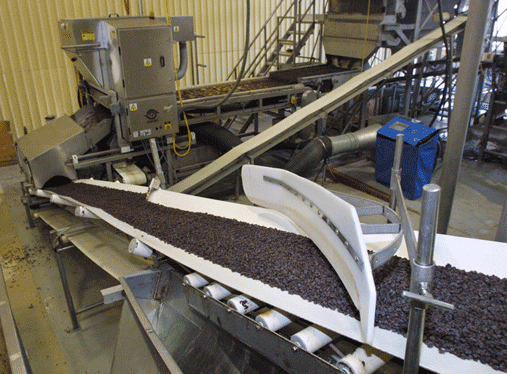
Raisins enter the washing system by conveyer, at a rate of 200 tons per day.
For all of these reasons, the Bedrosian family, owners of National Raisin Company, wanted to find an alternative to land applications. They were raised in the Fowler area, near the raisin processing plant, and are involved in local civic activities. They take pride in their community, and the company has always been committed to protecting the local environment.
“This is a small town,” says Ernie Bedrosian, president, and the eldest of three brothers who own the company. “There are only four or five thousand people and we know just about everybody. There are cheaper ways to dispose of the raisin wash water, but we wanted to do the right thing for the community.”
As time-consuming and environmentally unfriendly as land application can be, sending the water to the local municipal wastewater plant, is not an attractive alternative. It costs more to process water with high BOD, so municipal wastewater plants charge their customers more—about $50,000 per month more in National Raisin’s case.
Not surprisingly, the packer decided it would be more economical to remove the sugar—the source of the BOD—from the wash water. This would reduce municipal wastewater charges and eliminate the environmental concerns that came with land application.
So, the decision to remove sugar from the wash water before disposal was easy. Making it even more so was the fact that, if the grape sugar concentration in the wash water was high enough, it could be sold to local distilleries to make grape alcohol. This alcohol, in turn, is used to make fortified wines like sherry and port, and to make brandy. One local distillery said it would be interested in purchasing the water if it was a minimum of 8% sugar. This meant that the sugar content had to be doubled or quadrupled from the 2% to 4%, which was normal in the raisin wash water. The more difficult decision, then would be to decide how best to concentrate the raisin wash water, since there were several options.
The most logical choices were evaporation or reverse osmosis (RO). Even state-of-the-art, high-efficiency evaporators, operating under vacuum, require a lot of energy to boil away enough wash water to concentrate the sugar to the desired level. Reverse osmosis, on the other hand, only requires energy enough to generate pressure that forces water through a membrane that retains and concentrates the sugar. Thus, RO seemed the most likely approach.
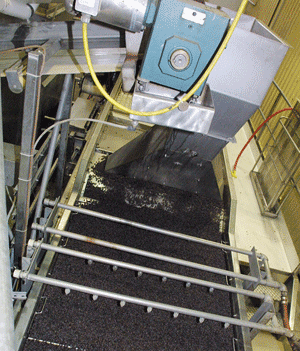
Millions of raisins are spread out in preparation for washing.
Plant Engineer John Minazzoli says they considered spiral RO elements, which are relatively inexpensive and require the least floor space. But dust and other grape solids (bits of stems and skins) were found to block the small channels in these spiral elements. Conventional pre-filters used upstream from the spiral elements also became blocked.
At this point, Mr. Minazzoli raised the question with Dr. Jatal Mannapperuma from the California Institute of Food and Agricultural Research (CIFAR). Dr. Mannapperuma consults with growers all over California and operates a mobile trailer that houses several membrane options for experimentation.
First, they tried using tubular ceramic membrane ultrafiltration (UF) as the prefiltration prior to the spiral RO. The filtrate from the ceramic UF unit provided an acceptable feed for the spiral RO, but unfortunately, the dust flowing through the ceramic membrane eroded the membrane surface, reducing its life.
At this point Dr. Mannapperuma recommended evaluating polymeric tubular RO membranes, and Peter Allan, then a sales engineer for PCI Membrane Systems and now one of the principals at Membrane Specialists LLC, was brought in. The ½” (13 mm) tubular channels in RO membranes do not require prefiltration, and the polymer membrane surface is more resistant to abrasion than inert materials such as ceramics. In other words, National Raisin could accomplish their goal of sugar concentration in one step instead of two.
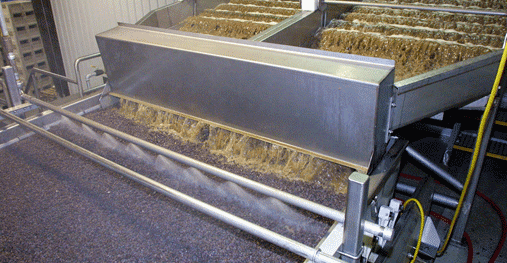
Raisins cascade through the washing process, which yields between 60,000 and 80,000 gal/day of wastewater.
The initial trial in the CIFAR trailer proved that the tubular RO concentrated the sugar up to the 8% to 10% levels required by the distillery, and additional scale up trials were then arranged directly with Mr. Allan to determine the size of the final system. The larger scale trials were also successful, and a full-scale system was installed.
Once the concentrated sugar water (called “retentate” in membrane-filtration parlance) has been removed, the remaining water (called the “permeate”) is actually lower in dissolved solids than the well water that feeds the plant. Therefore, it can be re-used in the raisin washing process or sent to irrigate nearby vineyards without any concerns about odor or soil contamination.
The membrane filtration plant installed at National Raisin Company incorporates 80 Model B1 filtration modules and is designed so that it can easily be expanded 50% to 120 modules to meet increased demand in the future. Membrane life is guaranteed for a year, and the first set was replaced after a year of use.
“PCI Membrane Systems was very good to work with,” says Mr. Minazzoli. “Peter Allan and the people at their main plant (located near Cincinnati, OH) were very knowledgeable and helpful. Even after the system was installed they were there to assist us whenever we needed them.”
National Raisin is continuing their program of optimizing RO use for maximum return on their investment. Demand for grape sugar water tends to fluctuate — even dropping to zero occasionally, but the savings on National Raisin’s sewer bill alone amounts to around $300,000 per year. This is enough to keep the system return-on-investment within the original plan of 3 years. Any additional income that comes from selling the concentrated sugar water to distilleries will just speed things up. And in the meantime, the Bedrosian family knows that they’ve done the right thing for the environment and for their neighbors.
Membrane Specialists LLC takes an unbiased approach to crossflow membrane selection, ensuring truly independent solution, ideal for each application. Membrane Specialists offers the full range of membrane geometries, incuding spiral wound, hollow fiber and both ceramic and polymeric tubular membranes. This choice of configurations makes it possible to test across the entire filtration spectrum from reverse osmosis, through nanofiltration and ultrafiltration to microfiltration. Trials can be carried out in Membrane Specialists laboratories or at your site, with or without assistance.
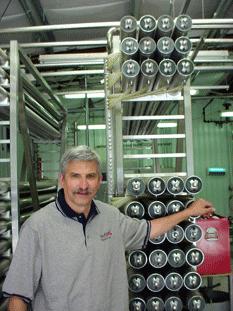
John Minazzoli and the membrane filtration system at National Raisin.
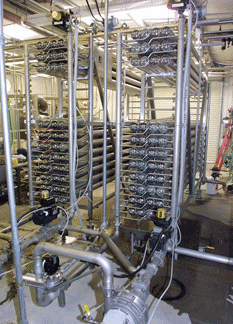
The membrane filtration plant installed at National Raisin Company incorporates 80 Model B1 filtration modules and is designed so that it can easily be expanded 50% to 120 modules to meet increased demand in the future.
